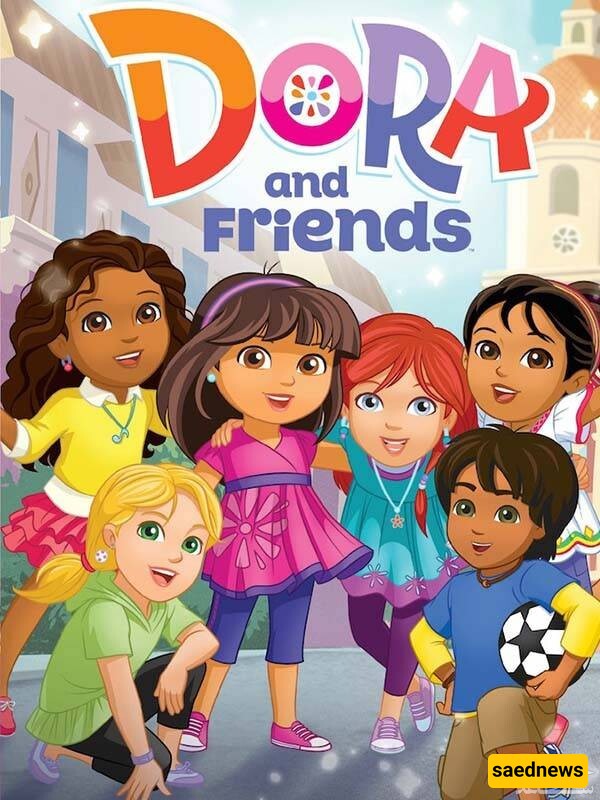One of the best methods for children to learn English, which you have probably heard a lot about, is learning through movies and cartoons. This method is highly effective, engaging, and effortless. In this article, we will explore how cartoons can be an excellent way to teach English to children.

One of the most exciting and interesting phases of English learning is when it is taught to children. Kids are full of energy and enthusiasm, making them eager to learn, which in turn creates a lively classroom atmosphere. The method of teaching English to children differs from that of other age groups. Teaching through nursery rhymes, educational games, and watching English-language cartoons and animations not only aligns with children’s interests but also effectively teaches them the language.
When teaching English, it is essential to consider factors such as the age of the learners, their English proficiency, and their learning goals before selecting an appropriate teaching method. Different age groups have varying learning abilities and preferences. For instance, an English class designed for adults, where current affairs are discussed, would be incomprehensible and unengaging for a child or teenager.
Children’s minds are open to new experiences, making it easier for them to learn English at a young age compared to adults. Kids love playing games and watching cartoons because they have vivid imaginations. They often immerse themselves in cartoon worlds, reenacting scenes in their games.
So, in response to the common question, “Can children learn English by watching cartoons?” the answer is a resounding yes! Watching cartoons and animations is an excellent method for teaching English to kids. It makes learning more enjoyable and accelerates language acquisition. Just as adults learn and reflect while watching movies and series, children's minds also engage with and absorb content from cartoons.
Watching animations, cartoons, or any visual content helps the brain retain information more effectively. Cartoons evoke emotions, and as we watch, our feelings change accordingly. Sometimes, we even imagine ourselves in the story, identifying with the characters. This emotional connection helps us remember what we’ve watched for a long time.

Since memories are often tied to emotions, anything that triggers a strong feeling tends to stay in our minds. This is why using cartoons as an English-learning tool is considered highly effective and fast.
Using cartoons to teach English has several benefits, including:
Engaging and Meaningful Content: Most cartoons contain important life lessons, teaching values like good vs. bad, self-confidence, perseverance, and problem-solving.
Simple and Slow-Paced Speech: Conversations in cartoons are often clear and slow, helping children recognize words and learn proper pronunciation.
Authentic Language Use: The dialogues in cartoons reflect everyday English, including common phrases that may not be found in textbooks.
Learning Without Grammar Stress: Young children may not understand grammar rules, but they can pick up simple sentences naturally through cartoons.
Stimulating Creativity: Cartoons are filled with imaginative ideas, visual effects, and lively music, which make them highly engaging for curious young minds.
Repetition for Reinforcement: Since cartoons often use repetitive language, children can memorize words and phrases effortlessly.
Short and Time-Efficient: Most cartoons last between 10 to 20 minutes, making them easy to fit into daily schedules.
Although watching cartoons enhances children’s language skills, parents must carefully choose appropriate content based on age, comprehension level, conversation speed, sentence length, and theme.
For optimal results, each cartoon or animation should be watched at least twice. Many children enjoy watching their favorite cartoons multiple times without getting bored. Parents can use this habit to reinforce learning by allowing them to watch one episode per day.
For longer animations, parents should first let children watch the full movie to grasp the main story. Then, they can break it into shorter sections, playing each segment two to three times. This approach ensures that children fully understand the dialogues and can repeat the words and phrases correctly.
Choose the Right Cartoon: Parents should carefully select cartoons based on their child’s interests and language level. For example, if a child loves princess stories, Frozen would be an excellent choice.
Watch with Bilingual Subtitles: Parents and children should first watch the cartoon with English subtitles rather than in their native language. This helps in learning new words and their meanings.
Practice Through Games: After watching, children can reinforce their learning through fun activities. Parents can engage in role-playing games with their children, using words and phrases learned from the cartoons.
Cartoons are enjoyable for all ages. However, some animations contain romantic, scary, or adventurous themes that may be more suitable for older audiences. English-learning animations for adults can be categorized into three types:
Educational Animations: Designed for preschoolers, these cartoons introduce basic vocabulary through songs, games, and interactive content.
Entertaining Animations: Some cartoons are purely for entertainment and humor, making them ideal for learners looking to improve their listening skills.
Classic Animations: These often depict folktales and legends, providing insights into different cultures.
Cartoons are a fantastic starting point because they are visually engaging, feature lively music, and are usually short, preventing children from losing interest. Parents should choose cartoons with clear English pronunciation and, if possible, watch them with their children to help explain the story. Below are some great choices:
Arthur: A long-running cartoon featuring a young boy named Arthur dealing with humorous school and family situations.
Dora and Friends: Encourages interaction by prompting viewers to respond to questions.

Maya & Miguel: Focuses on family and friendship, helping kids learn conversational English.
Phineas and Ferb: Contains clever humor and useful everyday vocabulary.
Word Girl: An educational yet entertaining show that introduces new words through fun challenges.
The Boss Baby: A hilarious cartoon enjoyable for both kids and adults.
Teen Titans: More suitable for children aged 8 and above due to its complex dialogue.
Avatar: The Last Airbender: A captivating adventure series with martial arts and Eastern mythology.
Scooby-Doo, Where Are You?: A classic mystery-solving cartoon that even adults enjoy.
Inspector Gadget: Follows a part-robot detective solving various cases.
Using cartoons and animations as a language-learning tool is an effective, enjoyable, and fast way for children to pick up English. This method improves listening skills, enhances vocabulary retention, and helps with correct pronunciation. By carefully selecting the right content and encouraging repeated viewing, parents can ensure a fun and effective English-learning experience for their children.

